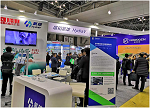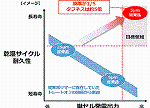燃料电池车辆用电池失效分析中膜电极?针孔的四种检测方法研究
燃料电池车辆用电池失效分析中膜电极针孔的四种检测方法研究
Comparative study of pinhole detection methods for automotive fuel cell degradation analysis
?Michael Obermaiera???????????????????????????????????????????????????????????????????? Krzysztof Jozwiaka
Markus Raubera Andreas Bauera
ChristinaScheubc
Abstract
Knowledge gained by fuel cell degradation analysis is important for meeting durability targets and thus for the commercialization of polymer electrolyte membrane fuel cells. Herein, the application of the most appropriate characterization method is crucial depending on which degradation mode is dominating. One major failure mode in polymer electrolyte membrane fuel cells is the formation of pinholes in the polymer membrane. In this work, a systematic study of four promising methods for pinhole detection is performed, namely detection via infrared camera, via He-gas detection as well as via pressure drop and hydrogen crossover measurements between anode and cathode. In particular, detection limits as well as influences of the material system and other relevant factors are discussed. Finally, a comparison of the different methods and a recommendation for their practical application is given to optimize detection of membrane defects in the field of failure analysis. The most successful ones are then tested for the analysis of real automotive stacks before and after operation.

耐久测试后的电极图像,虽然看上去还好,
但作者是专家,看出厚度下降,阴极孔隙率下降(影响气体渗透),MPL粘附,铂沉积(ECSA下降)。
Fig. 1 (D) illustrates the severe thickness decrease and the complete porosity loss of the cathode electrode as well as MPL adhesion and Pt deposition on top of the degraded cathode electrode. This altered cathode electrode porosity can lead to a strong decrease in gas permeability towards electrochemicalactive sites. In addition, Pt deposition on top of the degraded cathode electrode (see Fig. 1 (D)) and Pt crystallite growth of up to 100% compared to begin of life reference samples, as measured with X-ray diffraction, were found. This indicates a decrease in electrochemical active surface area.

实际针孔的大小为40微米。

GDE/GDL thickness are measured with a universal micrometer (Frank PTI 16502, tip diameter 5 mm, applied pressure 125.2 kPa).厚度计的测量压强是125kPa。

第一种针孔检测技术:红外热成像法

针孔为200微米时,红外热成像法可以获得的定位信息。
GDE电极不同,热导不同,同样的热棒,检测到的温度有4度的差异。

不同的材料体系下,不同的针孔尺寸造成的局部温度上升。电极材料不同,热导不同,检测到的温度最大偏差可以达到16度。有的材料体系对针孔敏感,而有的材料体系对针孔并不敏感。
没有针孔的条件下的温度梯度并不可靠,大功率燃料电池的材料缺陷无处不在。

针孔尺寸进一步缩小,到30-50微米状态,氢氧压差逐渐增加时,模拟电池的局部温升最大为3度,而真实电池和电极材料的选择相关,最大8度,小的为3度。
而且气体扩散层的覆盖会影响局部温升的测量,小氢氧压差下有的会造成35的偏差,有的偏差仅仅3度。

Within this MEA, two pinholes with diameters of approximately 10
μm and 20 μm are found with microscopic investigation. These pinholes could however not be detected with IR-thermography。说明了检测下限
第二种针孔检测技术:氦检,检测范围在5-10微米。但是这种方法的测试结果和探头的尺寸竟然有关系。使用不同的材料,膜的针孔大小相同,使用不同的探头尺寸测试到的氦流量竟然不同。
使用假电极,几乎无氦流量,而是用Nafion电极,氦流量约2个单位。氢氧压差50kPa,5微米针孔,氦流量约2个单位-4个单位。10微米针孔,氦流量约4个单位-8个单位。
第三种针孔检测技术:压降法。
第四种针孔检测技术:电化学法。
第五种针孔检测技术:同向供气循环开路加速测试下的燃料电池质子交换膜失效
第五种方法的检测限也大致在5微米。
第六种针孔检测技术:光学显微镜
作者总结如下

作者的表格中有笔误,读者可以挑挑错。
Conclusion
Four promising methods for pinhole detection, namely detection via
infrared-thermography, helium-gas detection, pressure drop and
hydrogen crossover measurements, are investigated and compared by
means of their detection limits and dependencies e.g. on the material
system such as Pt loading and morphology of the carbon network.
Pressure drop and hydrogen crossover measurements are found to be
fast and relatively easy implementable methods with detectable pinhole diameters of approximately 100 μm and 40 μm for the investigated material and the used test station, respectively. Herein, detection limits of pressure drop and hydrogen crossover methods depend on material properties of the investigated MEA. Detection of reaction heat of crossover hydrogen by infrared-thermography and detection of heliumgas concentration above a pinhole require additional cell hardware with a perforated clamping plate. Detection by infrared-thermography enables a fast localization of pinholes. Detected pinhole sizes are strongly dependent on both electrode and GDL properties as well as on hardware positioning and varies between diameters of 10 μm and 100 μm for the investigated materials. For the material system used in this work, the use of a helium-gas detector enables the localization of pinholes with a diameter of 5 μm (smallest pinhole size that we could fabricate), with the detection limit being dependent on GDL gas permeability and hardware positioning. Scanning of the whole MEA is more time consuming as for other methods. Due to the diversity of membrane degradation, different analysis tasks may arise ranging from fast screening of a general membrane failure to a sensitive localization of small pinholes. Therefore, a comparison of the different methods and a suggestion for their application is given. The detection of membrane defects of MEAs from two automotive stacks demonstrates the applicability of the infrared-thermography and helium-gas detection in an automotive failure analysis process. In total, we suggest an assembly of different pinhole detection methods for an appropriate pinhole analysis.
原文标题 : 燃料电池车辆用电池失效分析中膜电极?针孔的四种检测方法研究
最新活动更多
-
5月21日预约直播>> 【线上直播】全链智联,全域质控:电力与能源行业的质量升级之路
-
即日-6.20立即申报>> 维科杯·OFweek 第十一届太阳能光伏行业年度评选
-
企业参编征集立即参编>> 零碳智造·工商业光储发展蓝皮书
-
限时申报立即申报>> 0Fweek 2025工商业光伏/储能行业榜单
-
7月30日免费参会>> OFweek 2025光伏储能工业应用场景专场研讨会
-
7月30日免费参会>> OFweek 2025工商业光储招商会及高耗能企业需求对接会








 分享
分享












发表评论
请输入评论内容...
请输入评论/评论长度6~500个字
暂无评论
暂无评论